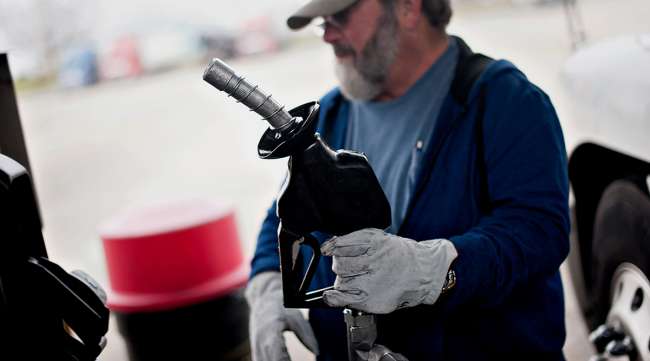Staff Reporter
Diesel Drops by 1¢ to $3.034 a Gallon

[Stay on top of transportation news: Get TTNews in your inbox.]
The U.S. average retail price of diesel dropped by 1 cent to $3.034 a gallon, the Department of Energy reported July 29.
Diesel costs 19.2 cents less than it did a year ago when it was $3.226 per gallon, DOE reported.
Regional diesel prices fell everywhere except California. The steepest decline was in New England, where the price of a gallon of diesel fell by 1.6 cent to $3.106.
Diesel ticked up only a bit in California, rising 0.1 cent to $3.940. California continues to have the highest diesel prices in the nation. The cheapest diesel price was reported in the Gulf Coast, at $2.793 per gallon.
Meanwhile, the price of gasoline fell 3.5 cents and now costs $2.715 a gallon on average.
Diesel and gasoline are thus at relatively low prices for summer, when consumption historically goes up. But there are warning signs in the markets and even on the oil fields of Libya, according to news reports.
Libya’s oil production dropped to about 950,000 barrels a day, its lowest in five months, after an unidentified group closed a valve on a pipeline linking the country’s largest oil field to an export terminal on the Mediterranean, according to Bloomberg News.
That, among other issues, pushed crude oil prices to their highest marks in more than two weeks as strong summer demand in the United States continued to drain fuel supplies, Bloomberg News reported. Futures on July 31 climbed as much as 1.3% after the U.S. Energy Information Administration said U.S. crude stockpiles fell by 8.5 million barrels, a seventh straight decline that was higher than all industry and analyst estimates, according to Bloomberg.
West Texas Intermediate for September delivery rose as high as $58.82 a barrel on the New York Mercantile Exchange on July 31.
To Phil Flynn, an oil analyst at the Price Futures Group of Chicago, it’s no surprise oil is on a bit of a bull run.
“Everyone got way too bearish,” Flynn told Transport Topics.

Flynn
He said even though the economy has slowed globally, Europe and China are preparing stimulus packages to boost consumption and their respective economies. Further, China’s oil import numbers are near record highs, Flynn said.
In the United States, the Federal Reserve plans to cut the interest rate to boost the economy, something that usually causes traders to push oil prices up, Flynn said.
And production cuts by OPEC will continue to shrink inventories, Flynn told TT. But Libya, with its political problems, already is priced into oil, Flynn said.
The only thing that could sink oil prices is a tweet or two from President Donald Trump, Flynn said, and that’s a real possibility. Flynn said Trump appears to be considering easing sanctions on Iran, a major oil producer, and that would ease upward pressure on oil.
Given the ups and downs of the oil market, and its effect on diesel pricing, efficiencies and savings become all the more important to the freight industry.
On July 30, the North American Council on Freight Efficiency held a news conference to discuss its “Idle Reduction Confidence Report,” which seeks to recommend ways to get trucks to save on diesel while reducing emissions. Idling is a major cost factor for fleets.
NACFE Executive Director Mike Roeth said diesel technology is changing for the better as diesel engines, the main trucking engines, are getting cleaner and more efficient. The problem the industry has is that drivers idle in summer weather so they are not sleeping in heated berths. Idling at other times also powers other amenities the sleeper area may have, but that drives up costs and emissions, Roeth said.

Roeth
He told reporters that by investing in technologies and practices, fleets can reduce idling from an average of 40% of on-the-road time to well below 20%, all while keeping drivers happy.
The NACFE report found that the most efficient and effective idle-reduction solution for a fleet is a combination of complementary technologies, including auxiliary power units, used together. Roeth told reporters that effective idle reduction could save fleets thousands of dollars per year in diesel costs. If a truck can reduce idling from 40% to 30%, the driver or fleet saves about $700 per truck annually.
If idling is reduced as low as 10%, which Roeth said is possible with certain technologies, the savings could be $2,100 per year, per truck.
Another group seeking to save the trucking industry money is the Diesel Technology Forum, a nonprofit organization that aims to improve the environmental and economic performance of diesel engines.
Allen Schaeffer, the forum’s executive director, told TT that because of federal legislation passed in 2005, diesel engines have gotten cleaner and more efficient.
The U.S. Diesel Emissions Reduction Act became effective in 2008. Since then, the law has raised $629 million to help upgrade or replace 67,300 older diesel engines, Schaeffer said. The Environmental Protection Agency oversees the funding.
Schaeffer said the program has been an ongoing success, reducing 472,000 tons of nitrogen oxide, an atmospheric pollutant, from diesel engines. The new engines also have reduced 15,500 tons of particulate matter and 5 million tons of carbon emissions.
But the bottom line for fleets has improved, too, Schaeffer said, as the U.S. trucking industry has saved 454 million gallons of diesel since the law took effect.




